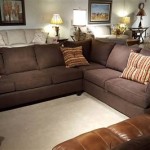Living Room With Leather Sofa Ideas: Style, Comfort, and Design Integration
The leather sofa stands as a timeless centerpiece in living room design, exuding an aura of sophistication and durability. Its versatility allows it to adapt to a range of interior styles, from classic and traditional to modern and minimalist. The purpose of this article is to explore various design strategies for incorporating a leather sofa into a living room, considering factors like color palettes, furniture pairings, accessory choices, and spatial considerations. The aim is to provide a comprehensive guide to achieving a harmonious and visually appealing living space centered around the leather sofa.
A leather sofa is an investment, and its longevity and aesthetic appeal depend on proper selection and care. Factors to consider when choosing a leather sofa include the type of leather, the frame construction, and the cushion filling. Full-grain leather is the highest quality, known for its durability and natural appearance, while top-grain leather offers a balance of quality and affordability. Bonded leather is the least expensive but also the least durable. The sofa's frame should be constructed from kiln-dried hardwood for stability and longevity. Cushion filling options include down, feathers, foam, and fiber, each offering varying levels of comfort and support. Understanding these factors is crucial to making an informed purchase that will serve as a focal point in your living room for years to come.
Color Palette Considerations for a Leather Sofa
The color of a leather sofa significantly influences the overall ambiance of a living room. Neutral shades like brown, black, and gray offer versatility and can be easily integrated into various design schemes. A brown leather sofa, for example, evokes a sense of warmth and earthiness, complementing natural wood tones and botanical elements. Black leather provides a more dramatic and sophisticated look, pairing well with metallic accents and clean lines. Gray leather offers a contemporary feel, serving as a neutral backdrop for bolder accent colors and textures.
When choosing a color palette, consider the size and lighting of the living room. In smaller spaces, lighter colors can create an illusion of spaciousness, while darker colors can make a large room feel cozier. Natural light enhances the richness of leather, while artificial lighting can alter its perceived color. It's essential to consider how the chosen color interacts with both natural and artificial light sources in the room.
Beyond the sofa itself, the color palette should extend to the walls, flooring, and other furniture pieces. Complementary colors, such as blue and orange or green and red, can create visual interest and balance. Analogous colors, such as shades of blue and green, offer a more harmonious and calming effect. Monochromatic color schemes, using different shades of a single color, can create a sophisticated and unified look. The key is to create a cohesive color scheme that reflects personal style and complements the leather sofa.
Furniture Pairing and Layout Strategies
The arrangement of furniture around a leather sofa is crucial for creating a functional and inviting living space. Consider the size and shape of the room when determining the layout. A common layout strategy is to create a conversational grouping, with the leather sofa as the anchor. This involves placing chairs, coffee tables, and side tables strategically around the sofa to facilitate interaction and create a sense of intimacy.
When choosing furniture to pair with a leather sofa, consider the style and materials. For a traditional living room, opt for wooden furniture with classic lines and intricate details. A coffee table with a carved base and upholstered chairs with rolled arms would complement a brown leather sofa. In a modern living room, consider sleek, minimalist furniture with metal or glass accents. A glass-topped coffee table and armchairs with clean lines would enhance the contemporary feel of a black leather sofa.
The layout should also consider traffic flow within the room. Ensure that there is ample space to move around the furniture without obstruction. Avoid placing furniture in walkways, and create clear paths between different areas of the room. A well-planned layout will not only enhance the aesthetic appeal of the living room but also improve its functionality and usability.
Area rugs can define the seating area and add texture and warmth to the space. Choose a rug that complements the color and style of the leather sofa and other furniture pieces. A large rug that extends under the front legs of the sofa and chairs will create a cohesive and unified look. Smaller rugs can be used to define specific areas within the room, such as a reading nook or a gaming area.
Accessorizing and Styling with a Leather Sofa
Accessories play a vital role in personalizing a living room and enhancing the visual appeal of a leather sofa. Throw pillows, blankets, artwork, and decorative objects can add color, texture, and personality to the space. The key is to choose accessories that complement the style and color of the sofa and reflect personal taste.
Throw pillows are an easy and affordable way to add color and texture to a leather sofa. Choose pillows in a variety of sizes, shapes, and patterns to create visual interest. Consider using different fabrics, such as velvet, linen, or silk, to add depth and dimension. A mix of solid colors and patterned pillows can create a balanced and harmonious look. For a brown leather sofa, consider using pillows in earth tones, such as beige, cream, and olive green. For a black leather sofa, opt for pillows in bold colors, such as red, yellow, or blue.
Blankets can add warmth and comfort to a living room, especially during the colder months. Choose a blanket that complements the color and style of the leather sofa. A knitted blanket in a neutral color can add texture and warmth to a brown leather sofa. A faux fur throw can add a touch of luxury to a black leather sofa. Drape the blanket casually over the back of the sofa or fold it neatly on the armrest.
Artwork can add personality and sophistication to a living room. Choose artwork that reflects personal taste and complements the style of the sofa. A large abstract painting can make a statement above a leather sofa. A gallery wall featuring a collection of framed prints can add visual interest and personality to the space. Consider the colors and textures of the artwork when choosing pieces to complement the leather sofa.
Lighting is a critical element in creating ambiance and highlighting the leather sofa's features. A combination of ambient, task, and accent lighting will create a well-lit and visually appealing living room. Ambient lighting, such as overhead fixtures or recessed lighting, provides general illumination. Task lighting, such as floor lamps or table lamps, provides focused light for reading or other activities. Accent lighting, such as spotlights or picture lights, highlights specific features of the room, such as artwork or architectural details.
Plants can add life and vibrancy to a living room, creating a sense of connection to nature. Choose plants that thrive in the lighting conditions of the room. Potted plants can be placed on side tables, coffee tables, or on the floor. Hanging plants can add visual interest and create a sense of verticality. Consider using a variety of plant sizes and shapes to create a dynamic and visually appealing display.
Ultimately, the key to accessorizing and styling a living room with a leather sofa is to create a space that reflects personal style and preferences. Experiment with different colors, textures, and arrangements until you find a combination that you love. Don't be afraid to mix and match different styles and eras to create a unique and eclectic look.
Maintaining a leather sofa involves regular cleaning and conditioning to preserve its appearance and prevent cracking or fading. Dust the sofa regularly with a soft cloth or vacuum with a brush attachment. Clean spills immediately with a damp cloth and a mild soap solution. Condition the leather every few months with a leather conditioner to keep it supple and prevent it from drying out. Avoid placing the sofa in direct sunlight or near heat sources, as this can cause the leather to fade and crack. Proper care and maintenance will ensure that your leather sofa remains a beautiful and durable centerpiece in your living room for years to come.
:strip_icc()/leather-sofa-living-room-ideas-2-proem-studio-white-oak-bbcb9cff21384c118adb7d407a843ebc.jpeg?strip=all)
23 Living Rooms With Leather Sofas That Look Incredible

How To Decorate A Living Room With Leather Furniture
:strip_icc()/102709366-ac6109a59bb5475089f803f57cf2ea48.jpg?strip=all)
5 Ways To Decorate With Leather Furniture

Decorating Around A Leather Sofa Centsational Style

Best Brown Couch Ideas For Your Living Room Farmhousehub

Living Room Inspiration Tan Leather Sofa

16 Best Leather Sofas 2024 For Living Room Cozy Couches

22 Living Rooms With Leather Furniture Page 2 Of 5 Room Brown Sofa Sets

Living Room Inspiration Tan Leather Sofa

Brown Leather Sofa Inspirational Living Room Ideas Decoholic








